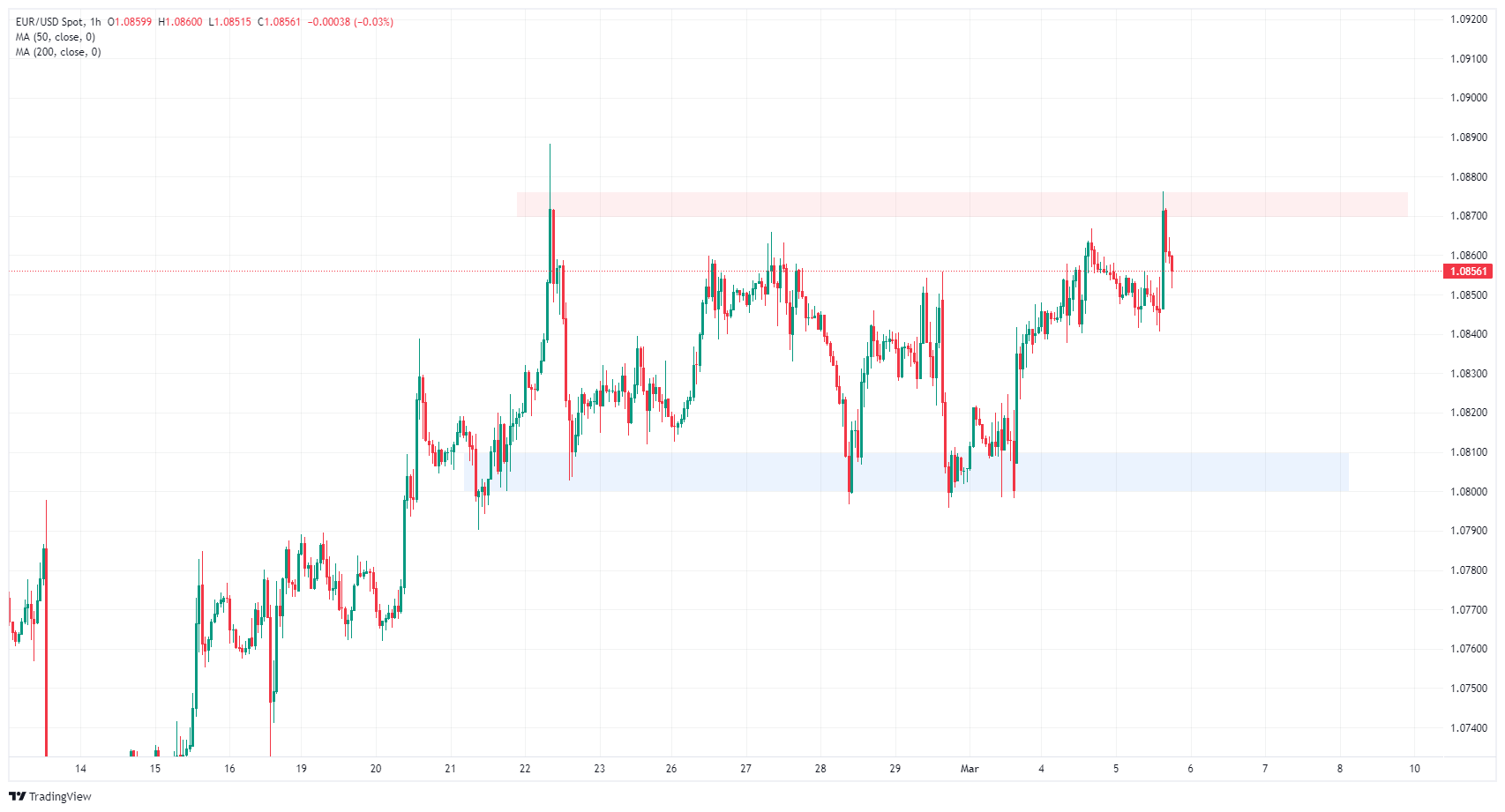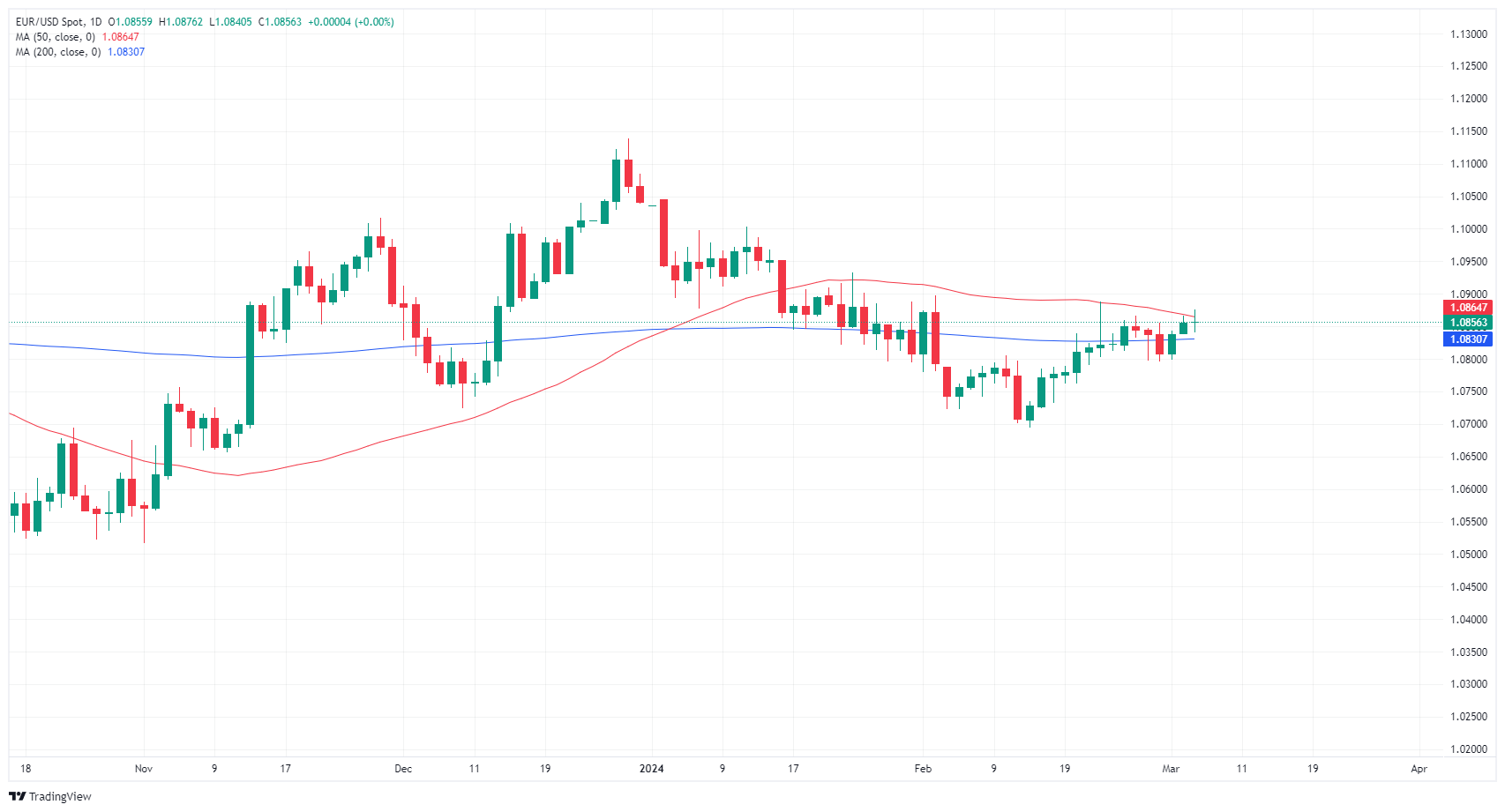- Analytics
- News and Tools
- Market News
- EUR/USD grinds to flat after market absorbs US PMI miss
EUR/USD grinds to flat after market absorbs US PMI miss
- EUR/USD rotates around 1.0850 once more.
- US data missed expectations, briefly weakening the US Dollar.
- European PMIs broadly beat, but Europe’s PPI missed.
EUR/USD drove into a fresh intraday high of 1.0876 on Tuesday but flopped back to the day’s opening bids after the market readjusted following a worse-than-expected print in the US ISM Services Purchasing Managers Index (PMI).
Europe’s final HCOB Composite PMI for February printed above expectations after finding additional calculation gains over the preliminary print. However, the pan-European Producer Price Index (PPI) failed to recover as markets had expected. Tuesday’s US PMI missed expectations, and markets will be pivoting to keep an eye out for key US labor figures and a two-day appearance from Federal Reserve (Fed) Chair Jerome Powell.
Daily digest market movers: EUR/USD returns to midrange after cycling on Tuesday
- Europe’s final HCOB Services PMI for February rose to 49.2 versus the expected hold at the preliminary print of 48.9.
- The euro area’s January MoM final PPI missed the mark, holding at the preliminary -0.9% versus the expected rebound to -0.1%.
- The US ISM Services PMI for February fell faster than expected, declining to 52.6 versus the forecasted downtick to 53.0 from 53.4.
- US Factory Orders in January also saw accelerated declines, printing at -3.6% versus the forecast of -2.9%. The previous month saw a downside revision to -0.3% from 0.2%.
- EU Retail Sales are due early Wednesday, with the European Central Bank’s (ECB) next rate call slated for Thursday.
- Fed chairman Jerome Powell speaks on both Wednesday and Thursday, testifying before the US government’s House Financial Services Committee.
- US ADP Employment Change figures also due Wednesday as a precursor to Friday’s US Nonfarm Payrolls (NFP) print.
Euro price today
The table below shows the percentage change of Euro (EUR) against listed major currencies today. Euro was the weakest against the Japanese Yen.
| USD | EUR | GBP | CAD | AUD | JPY | NZD | CHF | |
| USD | -0.01% | -0.13% | 0.09% | 0.01% | -0.32% | 0.14% | -0.19% | |
| EUR | 0.00% | -0.13% | 0.09% | -0.02% | -0.31% | 0.13% | -0.16% | |
| GBP | 0.13% | 0.13% | 0.21% | 0.10% | -0.18% | 0.27% | -0.04% | |
| CAD | -0.08% | -0.09% | -0.22% | -0.14% | -0.40% | 0.04% | -0.25% | |
| AUD | 0.01% | 0.02% | -0.12% | 0.12% | -0.28% | 0.15% | -0.14% | |
| JPY | 0.32% | 0.32% | 0.16% | 0.42% | 0.29% | 0.46% | 0.14% | |
| NZD | -0.14% | -0.16% | -0.28% | -0.06% | -0.15% | -0.48% | -0.29% | |
| CHF | 0.17% | 0.16% | 0.03% | 0.27% | 0.18% | -0.15% | 0.31% |
The heat map shows percentage changes of major currencies against each other. The base currency is picked from the left column, while the quote currency is picked from the top row. For example, if you pick the Euro from the left column and move along the horizontal line to the Japanese Yen, the percentage change displayed in the box will represent EUR (base)/JPY (quote).
Technical analysis: EUR/USD remains trapped near 1.0850
EUR/USD continues to struggle to find adequate bullish momentum to peel the pair off its 200-day Simple Moving Average (SMA) at 1.0830, and intraday bids are stuck near 1.0850. Topside gains are capped by a 50-day SMA grinding into a congestion pattern with the 200-day SMA.
The pair has struggled to chalk in additional gains after recovering from the last swing low into 1.0700. Growing risk of a technical ceiling priced in below 1.0900 leaves the pair exposed to intraday congestion. Tuesday’s brief rally into 1.0875 saw a sharp pullback, and the pair has a technical floor baked in between 1.0800 and 1.0810.
EUR/USD hourly chart
EUR/USD daily chart
Euro FAQs
The Euro is the currency for the 20 European Union countries that belong to the Eurozone. It is the second most heavily traded currency in the world behind the US Dollar. In 2022, it accounted for 31% of all foreign exchange transactions, with an average daily turnover of over $2.2 trillion a day. EUR/USD is the most heavily traded currency pair in the world, accounting for an estimated 30% off all transactions, followed by EUR/JPY (4%), EUR/GBP (3%) and EUR/AUD (2%).
The European Central Bank (ECB) in Frankfurt, Germany, is the reserve bank for the Eurozone. The ECB sets interest rates and manages monetary policy. The ECB’s primary mandate is to maintain price stability, which means either controlling inflation or stimulating growth. Its primary tool is the raising or lowering of interest rates. Relatively high interest rates – or the expectation of higher rates – will usually benefit the Euro and vice versa. The ECB Governing Council makes monetary policy decisions at meetings held eight times a year. Decisions are made by heads of the Eurozone national banks and six permanent members, including the President of the ECB, Christine Lagarde.
Eurozone inflation data, measured by the Harmonized Index of Consumer Prices (HICP), is an important econometric for the Euro. If inflation rises more than expected, especially if above the ECB’s 2% target, it obliges the ECB to raise interest rates to bring it back under control. Relatively high interest rates compared to its counterparts will usually benefit the Euro, as it makes the region more attractive as a place for global investors to park their money.
Data releases gauge the health of the economy and can impact on the Euro. Indicators such as GDP, Manufacturing and Services PMIs, employment, and consumer sentiment surveys can all influence the direction of the single currency. A strong economy is good for the Euro. Not only does it attract more foreign investment but it may encourage the ECB to put up interest rates, which will directly strengthen the Euro. Otherwise, if economic data is weak, the Euro is likely to fall. Economic data for the four largest economies in the euro area (Germany, France, Italy and Spain) are especially significant, as they account for 75% of the Eurozone’s economy.
Another significant data release for the Euro is the Trade Balance. This indicator measures the difference between what a country earns from its exports and what it spends on imports over a given period. If a country produces highly sought after exports then its currency will gain in value purely from the extra demand created from foreign buyers seeking to purchase these goods. Therefore, a positive net Trade Balance strengthens a currency and vice versa for a negative balance.
© 2000-2024. Уcі права захищені.
Cайт знаходитьcя під керуванням TeleTrade DJ. LLC 2351 LLC 2022 (Euro House, Richmond Hill Road, Kingstown, VC0100, St. Vincent and the Grenadines).
Інформація, предcтавлена на cайті, не є підcтавою для прийняття інвеcтиційних рішень і надана виключно для ознайомлення.
Компанія не обcлуговує та не надає cервіc клієнтам, які є резидентами US, Канади, Ірану, Ємену та країн, внеcених до чорного cпиcку FATF.
Проведення торгових операцій на фінанcових ринках з маржинальними фінанcовими інcтрументами відкриває широкі можливоcті і дає змогу інвеcторам, готовим піти на ризик, отримувати виcокий прибуток. Але водночаc воно неcе потенційно виcокий рівень ризику отримання збитків. Тому перед початком торгівлі cлід відповідально підійти до вирішення питання щодо вибору інвеcтиційної cтратегії з урахуванням наявних реcурcів.
Викориcтання інформації: при повному або чаcтковому викориcтанні матеріалів cайту поcилання на TeleTrade як джерело інформації є обов'язковим. Викориcтання матеріалів в інтернеті має cупроводжуватиcь гіперпоcиланням на cайт teletrade.org. Автоматичний імпорт матеріалів та інформації із cайту заборонено.
З уcіх питань звертайтеcь за адреcою pr@teletrade.global.















